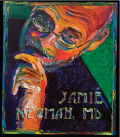Apophenia
There is a black cloud hanging over your head; the universe is out to get you.
The alarm doesn't go off because you set it for the wrong time. The coffee maker turned on, but it's a pot of hot water, because there was no coffee in the filter. You have to search the whole house to find your wallet and then your car keys. The hospital garage has no empty spots and you have to park 4 blocks away and it's raining. The elevator is too full to enter.
There is a black cloud hanging over your head—the universe is out to get you. Your brain sees a pattern, certain there must be a connection between all these events. Your internship is not going well.

It's your night on call. The team last night had no admissions at all. You think that maybe this will continue, and you hope to have a quiet night.
It doesn't, and you don't. In the space of 3 hours you have 6 admissions. Every single one has kidney injuries. You have acute kidney injury from acute tubular necrosis and acute interstitial nephritis and chronic kidney disease from diabetes and hypertension, not to mention glomerulonephritis and nephrosis. What is going on?
Surely the emergency department is out to get you. Every admission is more complex than the last. Meanwhile, the other team has nothing but simple cellulitis, kidney stones, and alcohol withdrawal. They are finished and sleeping before you have started your third admission. There is a pattern here—someone must be out to get you.
You step into a patient's room. He seems to be sleeping and you try to wake him. It's early in the morning. You wish you were sleeping too. The admission diagnosis is urinary tract infection with chronic kidney disease due to diabetes. He also had a motor vehicle accident several days ago. You think he must be having a nightmare as he is twitching in his sleep. His eyes are closed so you can't see his sclera. His skin looks slightly yellow, but you cannot be certain in this light. There are telangiectasias on his chest, and palmar erythema, and his liver seems enlarged. The lab shows a high mean corpuscular volume and low platelets. You note increases in his ALT and AST that have been attributed to mild trauma from his recent car wreck.
You present the patient to your resident and also tell her about the evidence of a conspiracy against you. She thinks you might be getting a little paranoid. She patiently sits and explains a few things to you, specifically that sometimes you see patterns where they don't exist and other times you can miss important ones. One is a type I error; the other, more dangerous, is a type II. Thinking that difficult admissions are destined to come to your black cloud service is definitely type I, but missing the signs and symptoms of renal failure in that patient you just saw is type II.
She tells you that the term “apophenia” was defined in 1958 by William Conrad as the “unmotivated seeing of connections” accompanied by a “specific experience of an abnormal meaningfulness.” Apophenia has come to imply a universal human tendency to seek patterns in random information. Examples include the gambler's fallacy—the mistaken belief that if something happens more frequently than normal during some period, it will happen less frequently in the future (or the reverse), popular in roulette betting—and pareidolia, where objects seem to form a pattern, like the headlights and grille of a car making a face or Nicolas Cage's face appearing on a piece of toast. For physicians, the most dangerous form of apophenia is overfitting, or taking data to imply an outcome that statistics don't support.
You try to accept your resident's comments and learn from them. The admissions seem to finally slow down—perhaps she may be right. You look at your patient again from a fresh perspective. You note the stigmata of liver disease, the elevated aminotransferase levels, the palmar erythema, the CBC. Then you notice a bigger pattern. The diabetes, the odd-colored skin, the liver disease, the arrhythmias. It hits you—hemochromatosis! It's the diagnostic highlight of your short medical career. You go home smiling, thinking perhaps the whole black cloud thing was just your imagination.
In the ED, the admitting physician smiles deviously to himself. He cannot stand your attending physician, and he made sure that all the sickest, most complex, and difficult patients had been admitted to your service that night. Sometimes there really is a pattern.



